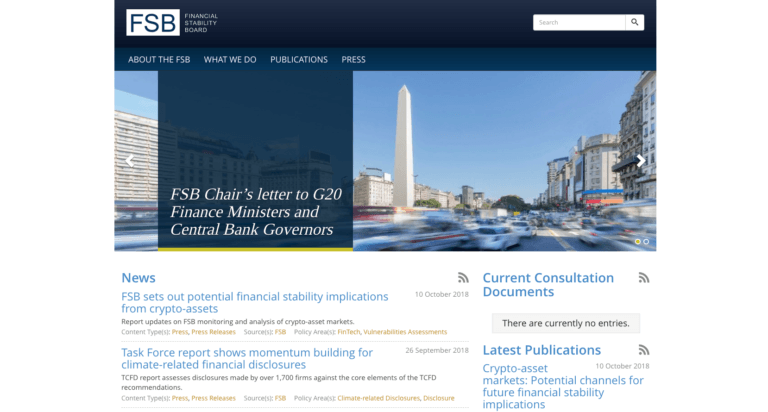On Wednesday (10 October 2018), the Financial Stability Board (FSB), “an international body that monitors and makes recommendations about the global financial system,” published a report titled “Crypto-asset markets: Potential channels for future financial stability implications.” Here, we look at the highlights from each of the four major sections of this report.
Introduction
First of all, it is important to note that the report focuses on “private crypto-assets” and does not consider “proposals for central bank digital currencies (CBDCs) or crypto-assets issued by other public sector entities.”
Second, it uses the term “cryptoassets” rather than “cryptocurrencies” because the FSB believes that at the present time such assets “do not reliably provide the standard functions of money and are often unsafe to rely on as a medium of exchange or store of value.” It also criticizes them for not being “backed by any government or other authority” and for not being “legal tender in any jurisdiction” (even though “some private enterprises and some public sector entities have chosen to accept some crypto-assets as payment”).
Next, there is a comment about the price volatility of cryptoassets:
“On 8 January 2018, the combined market capitalisation of crypto-assets peaked at an estimated $830 billion, of which approximately 35% was attributable to bitcoin. This later dropped to just above $210 billion as of 4 October 2018.”
The FSB notes that although it is going to “vigilantly monitoring the potential financial stability risks associated with crypto-assets, it recognises that the underlying DLT may provide some important benefits in the future.” Examples of areas where it thinks DLT could prove useful are “securities settlement, asset registers, trade reporting and financial inclusion.”
In addition to “potential financial stability concerns relating to any significant increases in the use of crypto-assets,” the FB is worried about broader issues, such as risks to consumer and investor protection and market integrity; sanctions evasion, fraud, and other illicit financing risks; and tax evasion. It says that these “problems are exacerbated when crypto-assets are not backed by an accountable entity that can be bound by regulation and held responsible for potential breaches of regulation.”
The FSB also points out that certain characteristics of cryptoassets may make them attractive to criminals, and names risk factors such as “their distributed, cross-border nature; their easy transferability; and the strong potential for anonymous or pseudo-anonymous crypto-asset transactions.” Another risk mentioned is that cryptoassets “are often transacted through entities operating in a non-compliant manner or with limited regulatory oversight.”
Primary Risks in Cryptoasset Markets
If there was to be significant growth in usage of cryptoassets, the following primary risks could potentially lead to financial stability implications:
- Market liquidity risks
- “Ownership of crypto-assets appears to be concentrated among relatively few market participants, limiting market depth and reducing the capacity of markets to accommodate large trading volumes.”
- “Operational issues on trading platforms can also lead to fragmented market structure.”
- “Illiquidity, concentrated ownership, fragmented market structure, and other issues also make crypto-assets potentially susceptible to price manipulation and other misconduct.”
- Volatility risks
- “The price volatility of the top two crypto-assets by market capitalisation was between six and 13 times higher than that of the euro, gold and the S&P 500 US equities index as of 4 October 2018.”
- “… the high volatility of crypto-assets may contribute to difficulties in their use for payments or settlement.”
- Leverage risks
- “Information about the role of leverage in crypto-asset markets is incomplete. According to one recent survey, nearly 20% of crypto-asset owners used debt to finance purchases.”
- “trading on margin is currently available to crypto-assets investors in some jurisdictions, providing leverage of between 2.5x and 100x.”
- Technological and operational risks including cyber security risks
- “Technological limitations and network governance issues regularly arise in networks for different crypto-assets.” (One example: “Decentralisation and lack of or inadequate governance makes it difficult to resolve technological limitations or errors and may lead to uncertainty and “hard forks” by a subset of miners.”)
- “Crypto-asset trading platforms can be, and in some cases have been, vulnerable to fraud, hacking, and other cyber incidents for a variety of reasons,24 including weak custody and cyber security arrangements and in many cases operating without being registered as regulated exchanges.”
Transmission Channels Affecting Financial Stability
- “… the primary risks present in the crypto-asset markets could have financial stability implications through a variety of other transmission channels.”
- “These include (i) confidence effects; (ii) financial institutions’ exposures to crypto-assets, related financial products and entities that are financially impacted by crypto-assets; (iii) the level of market capitalisation of crypto-assets; and (iv) the extent of their use for payments and settlements.”
- “it appears that risks to global financial stability are not significant at present, given the limited size of crypto-asset markets relative to other financial markets and the limited interconnectedness between crypto-asset markets and the regulated financial system. While the increase in prices was very large, and in fact larger than comparable historical asset bubbles, the market capitalisation relative to other financial markets and comparators has remained small.”
Regulatory Approaches and Communications
- “Different FSB member jurisdictions have taken and are actively considering a range of regulatory approaches to crypto-assets.”
- “These approaches have varied across jurisdictions. They include: regulating or increasing regulatory oversight of crypto-asset trading platforms, hosted wallets, and certain other intermediaries, for AML/CFT or other law enforcement purposes; regulatory guidance, including about the application of AML/CFT laws and securities and other applicable law and related consumer and investor warnings; registration or licensing regimes; clarification of the legal status of crypto-assets for tax purposes; regulatory sandboxes that permit pilot initiatives under close regulatory supervision; regulatory and other law enforcement actions; and bans on providing financial services to crypto-asset firms and/or on their use by financial institutions or for payment.”
Conclusion
The FSB believes that “crypto-assets do not pose a material risk to global financial stability at this time”, but due to “the speed of developments and the existence of data gaps”, it has “committed to monitoring the risks to financial stability on an ongoing basis, via a framework developed jointly with the Committee on Payments and Market Infrastructures (CPMI).” This framework “includes risk metrics that are most likely to highlight risks to financial stability, using data from public sources where available.”
Featured Image Courtesy of the Financial Stability Board








